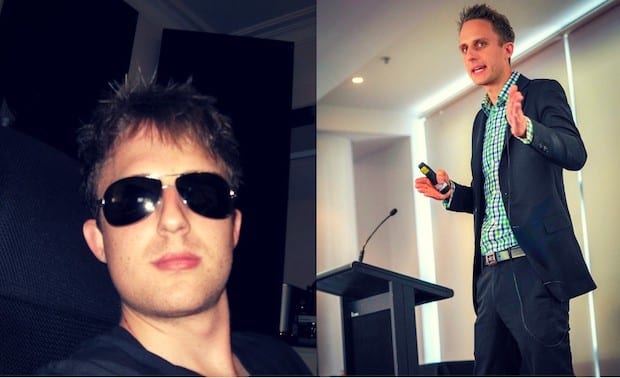Motivation
The Real Hack Is In The Doing.

I had a coaching call with a client recently and it was a trainwreck. I’m trying to get them to create content and they keep peering into the future. Instead of creating content they’re obsessed with:
- Sales Funnels
- When to monetize
- How to convert inquiries into customers
- What camera to use when filming videos
- Writing a whitepaper
I told them this:
“Screw all of that. The key to success is in the doing.”
Your Ideas change over time.
When I first started blogging in 2014, I was doing interviews with entrepreneurs and turning them into blog posts. I had no idea what I was doing or even why I was doing it.
The blog posts sucked and sounded like press releases.
I hated the process.
None of the blog posts got any engagement at all. Hearing entrepreneurs talk about raising money and selling widgets was boring to me.
Then, one night at around 8 pm I wrote a blog post about changing my life. It was all the lessons I learned from studying personal development and it was nothing more than a brain fart.
It took about 45 minutes to write and was published with spelling and grammar errors all the way through it. This post got shared 84,000 times on Facebook alone.
All of a sudden, through focusing on the doing, I found something I liked.
“What starts as an idea changes over time and you’ll never predict where things will end up. Trust in the process”
Your beliefs change too.
I told my coaching client that his beliefs would change too. What he believes right now will change in the future. This will shape his creative side and his content most of all.
“Trying to predict where you’ll be in the future is like trying to predict when you’re going to die - it’s impossible to know”
My beliefs initially about what I was doing came from a very self-centered view of the world that was all about the cliché version of success.
I thought the nice car, suit, house and bikini babe was what mattered. Pretty quickly, as I produced lots of content and began reading, after not touching a book for more than ten years, I saw a different side.
My beliefs about the world changed and the idea of money went to last place. Add on a couple of near-death experiences like a cancer scare and my beliefs are now completely different.
I’m no longer trying to figure out how to suck out as much value from the world as I can for my own benefit. What I do daily is about a purpose far bigger than myself.
I told my coaching client this story because I believed the same was true for him. He’s trying to impact people’s lives by getting them to fall in love with the work they do.
Whenever he starts talking about this topic, I feel inspired. I told him that I say no to so many clients because I don’t believe in what they do.
I believe in what he does and that’s why I’m obsessed with getting him to focus on the doing.
You learn as you go.
People have this obsession with the idea that you have to do a course, be mentored, study for years (insert excuse) before you can start doing what you love.
This is a ridiculous idea and I challenge you to a duel if you think this way. As you continue the doing aspect of what you love, you’ll learn at the same time.
Even if you’re not conscious about the learning side, the doing will reveal way more than waiting for accreditation, permission or a mentor’s approval to proceed ever will.
Everything I know about social media, blogging, inspiring people and entrepreneurship came from the doing. Yes, there was deliberate learning along the way but that was always a distant second to the doing itself.
Consuming vs. creating.
My coaching client also suffered from the battle that is consuming vs. creating. He spent too much time watching what everyone else was doing and he didn’t spend enough time creating his own art.
He’s currently posting one video a week and I told him that’s not enough. He has it within him to do at least one video a day if he quits consuming everybody else’s content.
He also told me that he feels the need to respond to every comment he gets on social media. I told him this is nuts!!!
You cannot respond to every comment or email you get online. This time is better spent creating than it is pumping up your ego with “thank you’s” and “yes I know I’m so smart.”
The tools change.
I started blogging on WordPress and now I do most things on Medium and LinkedIn. If I’d become too obsessed with the tools, then I would have wasted the time I could have been spending refining my craft.
All the tools you use to execute on doing what you love will change, so treat them secondary to creating your unique art.
You can’t preplan the doing 9 times out of 10.
Your best work is often done when you’re spontaneous. For example, today is a public holiday in Australia and I wouldn’t normally write on a Wednesday.
I felt inspired this morning though, so I decided to jump on the computer and do some creating. Some of my best work (if I look at the stats) has been done on public days and times when I didn’t plan to create anything.
Over planning is a trap you need to avoid if you want to get down to the doing which produces results.
The doing is the hardest part.
The reason why many of you reading this are so obsessed with mentors, education, online courses and consuming someone else’s content is because all of these things are easy.
The doing is the hardest part. Being creative takes up all of your energy and putting your work out there to be judged is hard on your ego.
“Creating truly inspiring work takes every ounce of your emotions. You need flow states, time, resources and the belief that you’re enough to do the doing”
What stops us from the doing is either procrastination or fear. These two evils prevent you from the doing without you often realizing.
My coaching client wants to make a massive impact and he’s scared that he doesn’t have the ability. As his coach, I know he does and I’ve seen it.
The battle that exists in your mind daily is whether you should be doing the doing or settling for something easier (often this looks like the same thing but it’s not!).
Spending time doing the very thing that is hard, is how you leapfrog everyone else that never gets what they want and never lives a fulfilled life.
How do you win so frequently?
That’s what my coaching client asked me. He wanted to know how I produce so much content and have so many people watching online.
I told him the truth: I just spend as much time as I can doing the doing.
Everything else seems to take care of itself when I embrace this simple hack. You must become obsessed with the doing.
Spend a disproportionate amount of time doing the doing and you’ll produce the results that are 10X of what you think you’re capable of.
Are you ready to win?
If you want to increase your productivity and learn some more valuable life hacks, then join my private mailing list on timdenning.net
Did You Know
7 Surprising Life Lessons Video Games Taught Me That School Never Did
Want to get better at something? Study the pros. That applies to both life and video games

If you play video games, you’ll quickly discover you’re not alone. You’ll meet people who share your interests, challenge your skills, and even teach you something new about yourself. I started gaming when I was 10. A classmate invited me to play after school, and I was hooked. (more…)
Featured
The Psychology of Motivation: How to Keep Moving Forward Every Day
Discover how daily habits, self-discipline, and a few clever strategies can spark your drive and focus.

You wake up on a typical Monday morning, glance at your clock, and realize it’s time to get moving. How do you summon that inner drive to deal with your responsibilities with a genuine smile on your face? (more…)
Motivation
From Couch Potato to Go-Getter: A Step-by-Step Motivation Plan for Everyone
By understanding what motivates you, you can turn your dreams into reality

Are you tired of feeling like a couch potato? Do you want to transform your life and become a go-getter? You’re not alone! Many people struggle with motivation, but the good news is that change is possible. (more…)
Motivation
Why You’re Failing to Achieve Your Goals and How to Fix It Now
Understanding motivation is crucial because it’s the cornerstone of success

Feeling stuck? Lost in a sea of goals, but lacking the drive to pursue them? It’s time to shift gears and reignite your motivation! Picture this: From stalled to soaring, your journey awaits. (more…)
-

 Success Advice4 weeks ago
Success Advice4 weeks agoThe One Mindset Shift That Made Me Irreplaceable At Work
-

 Did You Know3 weeks ago
Did You Know3 weeks ago7 Surprising Life Lessons Video Games Taught Me That School Never Did
-

 Success Advice4 weeks ago
Success Advice4 weeks agoHow Playing by the Rules Became the Smartest Business Strategy
-

 Success Advice3 weeks ago
Success Advice3 weeks agoHow to Build Trust, Kill Micromanagement, and Lead a Team That Thrives
-

 Scale Your Business3 weeks ago
Scale Your Business3 weeks agoHow to Build a Workplace People Actually Want to Show Up To
-

 Success Advice2 weeks ago
Success Advice2 weeks agoSuccess Isn’t Sexy: 5 Daily Habits That Actually Work
-

 Scale Your Business3 weeks ago
Scale Your Business3 weeks agoHow Smart Entrepreneurs Cut Financial Chaos in Half with One Simple Switch
-

 Success Advice2 weeks ago
Success Advice2 weeks agoBreaking the Bias: How Females Can Thrive In The Workplace in 2025

























